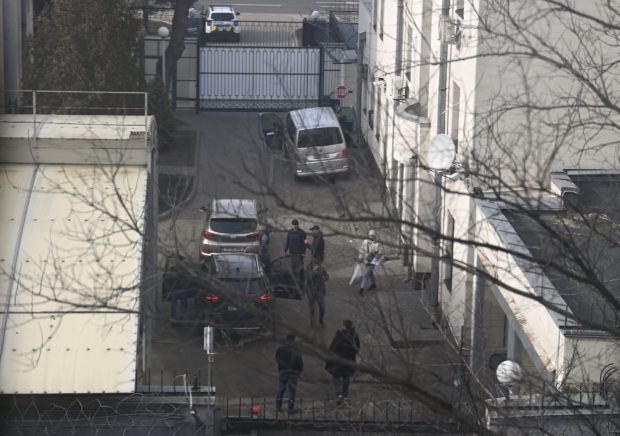Ukraine imposes state of emergency to face down Russia threat

Embassy staff members stand in the courtyard of the Russian Embassy in Kyiv, on February 23, 2022. AFP
KYIV — Ukraine’s parliament imposed a national state of emergency on Wednesday aimed at helping to forge a response to the threat of a Russian invasion.
The measure was overwhelmingly approved on the same day that Moscow began to evacuate its Kyiv embassy and Washington stepped up its warnings about the chances of an all-out Russian attack.
“The situation is difficult but remains completely under our control,” Ukraine’s security and defense council secretary Oleksiy Danilov told lawmakers ahead of the vote.
The state of emergency allows Ukraine’s regional governments to adopt heightened security measures that range from tighter ID and vehicle checks to more stringent policing.
It is due to enter into force on Thursday and stay in place for 30 days.
Article continues after this advertisement“Intelligence from all our foreign partners — as well as our own intelligence and analysts — show that it would be impossible to take over our country without first destabilizing the domestic situation,” Danilov said.
Article continues after this advertisementThe state of emergency applies to all parts of Ukraine except for two Russian-backed eastern separatist regions where a deadly insurgency has killed more than 14,000 people since 2014.
Kyiv mayor Vitali Klitschko told reporters that “mass events and strikes” would be banned across the country under the new rules.
He said specific measures for Kyiv include checkpoints at the main entrances into the capital as well as “special controls” at train stations and airports.
“We must be ready to defend our homes, families, city and country at any moment,” Klitschko said.
Surge in fighting
Russian President Vladimir Putin’s recognition of the eastern provinces’ independence on Monday sharply ramped up fears of an imminent war.
Putin has signed decrees allowing the deployment of Russian “peacekeeping” forces into rebel territories to back up the independence claims.
READ: Russia’s Putin announces military operation in Ukraine
The Russian leader said on Tuesday that his decision to send in the troops will “depend on the situation on the ground”.
But Russian state television has been filled with allegations from rebel leaders in the past few days accusing Ukrainian soldiers of launching deadly and unprovoked attacks against civilians.
Ukraine firmly denies the allegations.
The rapidly escalating tensions have forced US officials to ramp up their warning about the looming threat of an attack from at least 150,000 Russian forces believed to have encircled Ukraine.
Fighting across the eastern frontline surged last week after a months-long lull.
Ukraine has reported the death of six soldiers and one civilian in government-held regions in the past four days.
Monitors from the OSCE pan-European security body say the current level of fighting is particularly heavy in the rebel Lugansk region.
It reported 1,182 ceasefire violations in Lugansk in a daily tally released Wednesday and covering new breaches recorded through late Tuesday.
The level of violence is nearly double that in Donetsk — the larger of the two rebel provinces and the epicenter of violence over long stretches of the war.
RELATED STORIES
UK says: The Russian invasion of Ukraine has begun
Putin says Russia’s interests ‘non-negotiable’
Freeze or full invasion? Scenarios for Russia in Ukraine